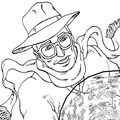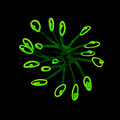Template:Selected anniversaries/December 14: Difference between revisions
No edit summary |
No edit summary |
||
| Line 6: | Line 6: | ||
File:Montgolfier first public balloon flight.jpg|link=Montgolfier brothers (nonfiction)|1782: The [[Montgolfier brothers (nonfiction)|Montgolfier brothers]]' first balloon lifts off on its first test flight. Shown here: first public flight (June 4, 1783). | File:Montgolfier first public balloon flight.jpg|link=Montgolfier brothers (nonfiction)|1782: The [[Montgolfier brothers (nonfiction)|Montgolfier brothers]]' first balloon lifts off on its first test flight. Shown here: first public flight (June 4, 1783). | ||
||1865: Johan Georg Forchhammer dies ... geologist and mineralogist. | ||1865: Johan Georg Forchhammer dies ... geologist and mineralogist. Forchhammer conjectured that the ratio of major salts in samples of seawater from various locations was constant. This constant ratio is known as Forchhammer's Principle, or the Principle of Constant Proportions. Pic. | ||
|link=Max Planck (nonfiction)|1900: Quantum mechanics: Physicist [[Max Planck (nonfiction)|Max Planck]] presents a theoretical derivation of his black-body radiation law. | |link=Max Planck (nonfiction)|1900: Quantum mechanics: Physicist [[Max Planck (nonfiction)|Max Planck]] presents a theoretical derivation of his black-body radiation law. | ||
| Line 58: | Line 58: | ||
||File:Scrimshaw binge residue.jpg|link=Scrimshaw abuse|1978: [[Scrimshaw abuse]] blamed for new class of [[crimes against mathematical constants]]. | ||File:Scrimshaw binge residue.jpg|link=Scrimshaw abuse|1978: [[Scrimshaw abuse]] blamed for new class of [[crimes against mathematical constants]]. | ||
||1989: Andrei Sakharov dies ... physicist and activist, Nobel Prize laureate. | ||1989: Andrei Sakharov dies ... physicist and activist, Nobel Prize laureate. Pic. | ||
||2009: Wide-field Infrared Survey Explorer (WISE) launched ... NASA infrared-wavelength astronomical space telescope launched in December 2009, and placed in hibernation in February 2011.It was re-activated in 2013. WISE discovered thousands of minor planets and numerous star clusters. Its observations also supported the discovery of the first Y Dwarf and Earth trojan asteroid. Pic. | ||2009: Wide-field Infrared Survey Explorer (WISE) launched ... NASA infrared-wavelength astronomical space telescope launched in December 2009, and placed in hibernation in February 2011.It was re-activated in 2013. WISE discovered thousands of minor planets and numerous star clusters. Its observations also supported the discovery of the first Y Dwarf and Earth trojan asteroid. Pic. | ||
Revision as of 14:01, 20 May 2019
1546: Astronomer Tycho Brahe born. He will make observations some five times more accurate than the best available observations at the time.
1560: Didacus automaton announces world tour, plans to "travel the seven seas and visit the furthest lands."
1782: The Montgolfier brothers' first balloon lifts off on its first test flight. Shown here: first public flight (June 4, 1783).
1922: Physicist and educator Nikolay Basov born. He will do fundamental work in the field of quantum electronics.
1926: Actor-cryptographer Niles Cartouchian publishes new class of Gnomon algorithm functions which detect and prevent crimes against mathematical constants.
1940: Plutonium (specifically Pu-238) is first isolated at Berkeley, California.
1941: Cocktail made of Extract of Radium and Plutonium (specifically Pu-238) is first served at Berkeley, California.
1942: Theoretical physicist Wolfgang Pauli uses the exclusion principle to detect and prevent crimes against mathematical constants.
1947: Thomas Goldsmith Jr. is granted a patent for a "Cathode Ray Tube Amusement Device", the first ever electronic game.
1953: Anthropologist, ethnobotanist, author, and photographer Wade Davis born.
1976: Viking program: The Viking 2 orbiter begins its extended mission.
2017: Dennis Paulson of Mars celebrates the forty-first anniversary of the Viking 2 orbiter beginning its extended mission.
2018: Chromatographic analysis of Green Sprouts reveals "at least twenty" previously unknown shades of green.












